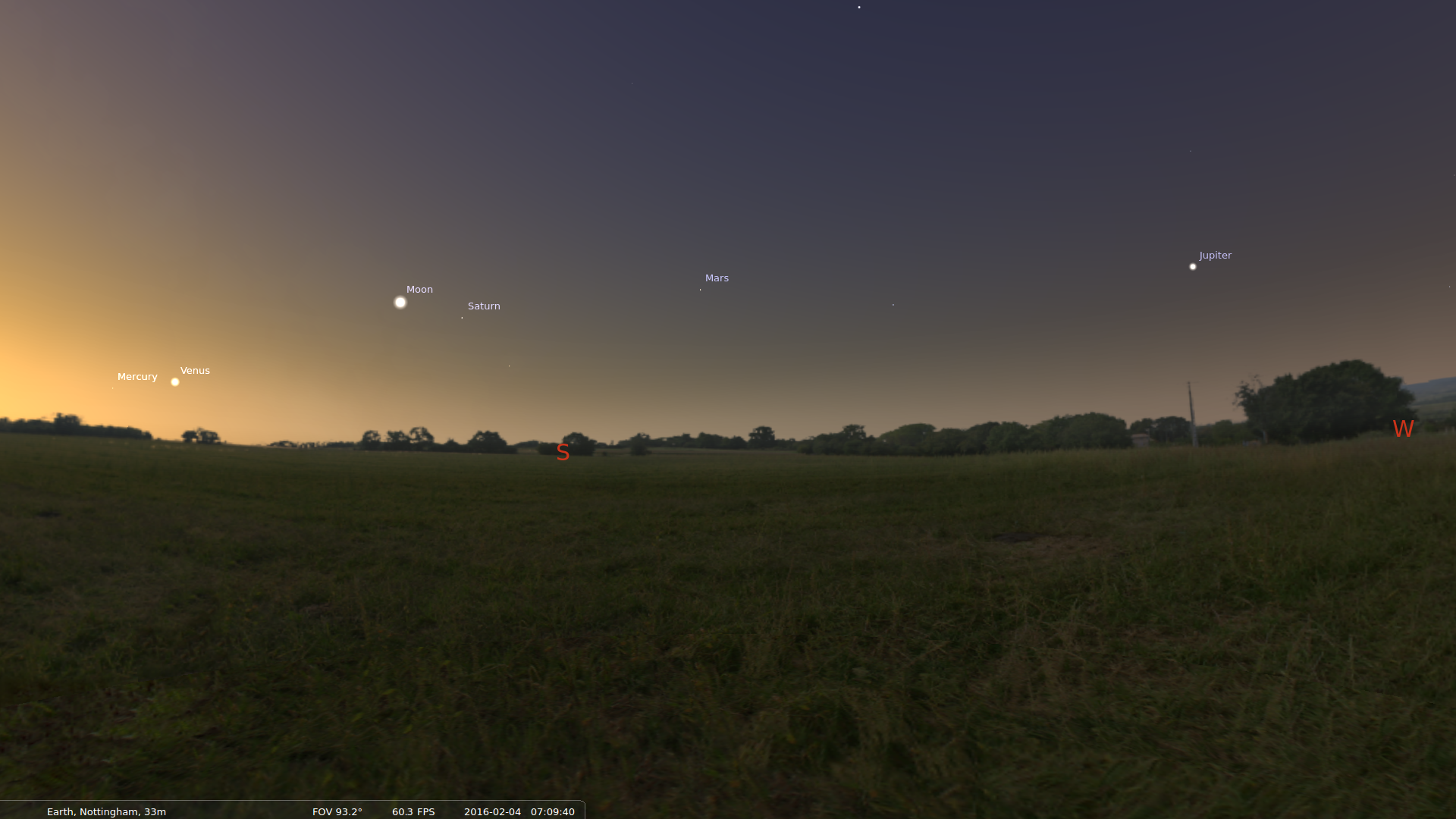
February 4, 2016, by Lindsay Brooke
The 5 Planet Waltz
If you are planning to get up early to see the brightest five planets all in alignment – an unusual sight but clear enough on a clear day before the sun rises to see with the naked eye – here’s some useful background information from astronomer Dr Julian Onions in the School of Physics and Astronomy at The University of Nottingham.
Over to you Julian.
If you get up early enough and IF the sky is clear, you may see or you may have seen quite a treat in the early morning sky. Five planets all visible in the sky.
Venus, Jupiter, Mars, Saturn and Mercury will all continue to be visible, clouds permitting, until about the 20th February. The best time to view them is around 6:45am, give or take a bit.
I’ve tried to get a photograph of the event, but clouds, and oversleeping have conspired against me, so here is a screenshot from Stellarium (a free night sky program) showing what it should look like. As you can see – it’ a fairly broad expanse, visible from SE to W.
Identifying your planets
Venus and Jupiter are really quite bright and fairly unmistakable to spot and the Moon is joining the party at the moment.
Mars is less bright, though still obviously visible, and does have a reddish tinge – but then so do some stars, so you need to get the right one.
Saturn is reasonably bright, but you won’t see the rings without at least a small telescope.
Mercury is the trickiest one to see. I’ve only seen it a few times in my life. As it is the innermost planet, it is always very close to the Sun, and so is only visible when it sets just after, or rises just before the Sun. It is also not very bright, so the sky needs to be dark enough to see it, and what with the Sun either about to rise, or just having set, conditions are never very ideal.
Here is a picture taken a few years ago from an upstairs window of Mercury. Bottom left is Mercury – very faint, top middle is Venus, and off to the side is a sliver of moon. You can still see the faint glow of the Sun on the horizon.
The wall of death
The planets, including our Earth all orbit around the Sun. Because of the way gravity operates they don’t all go around at the same speed. The most massive body in the solar system by far, is the Sun. So that has the most gravity, and that is what dominates, and that is why the planets all orbit the Sun. The next biggest planet, Jupiter, is less than 1000th the mass of the Sun. This is big for a planet, but small for a Sun.
Now back to gravity, gravity operates by the inverse square law, which means if everything else is equal, a body twice as far away from the Sun as the Earth, feels only 1/4 of the force of gravity from the Sun. This in turn changes how it orbits. A planet has to orbit at a speed fast enough to stop it falling into the Sun – something Johannes Kepler worked out in the 1600s.
If you think of a motorcycle on a wall of death, it has to go at a fast enough speed to keep stable, or when it slows down it will just fall to the floor. It’s the same for planets.
Mercury, the inner most planet has to shoot round in its orbit in just 88 days and travels at around 47 kilometers a second. When we get out to Jupiter, it takes 4332 days to complete and orbit and is dawdling around at just 13 km/s, and Pluto (not a planet) waddles around at 4 km/s.
When planetary orbits coincide
So with this in mind, the planets are all going around the Sun at different speeds in different orbits, so once in a while odd things will happen. Every now and again the orbits will coincide so that all the planets are in the same area of sky all at the same time. That is what we are seeing right now. It’s not a particularly uncommon event, it last happened last about 10 years ago, and will happen again in a few more years. The other two major planets, Neptune and Uranus are not on the same side of the sky, so even if they were visible to the naked eye you wouldn’t be able to see them.
Whilst all the 5 planets are visible, this doesn’t really count as a conjunction, which is where two or more planets come very close to each other. These come up fairly regularly, when planets or the moon get apparently very close to each other in the sky, which is just as a consequence of their orbits lining up with Earth’s viewpoint. They become rarer depending on how many planets you want and how close they appear to each other. Below is a conjunction of Jupiter and Venus I took back in June 2015.
And here’s one of the Moon and Jupiter back in December.
What does it mean?
There are other ways of lining up planets, you could have them all in a line extending out from the Sun. This happens about once every 500 years or so. In this case you wouldn’t be able to see the inner two planets, but you would be able to see the rest. In such cases the conspiracy theorist and crazies often come out, claiming climactic events, earthquakes, tornadoes and in a good year the end of the world is nigh.
I’ve lived through a number of these events. There was such an alignment from Mercury to Saturn on 5th May 2000 and I am still here.
In reality, given how massive the Sun is, other than the Moon, none of the other bodies in the Solar system have any detectable influence on us. They are just so tiny (in comparison) and so far away from us their influence is minuscule. Jupiter has the best chance, and its influence only 1% of what the Moon manages.
It used to be we only had our solar system as an example of how planets go around, but with the fantastic growth in exoplanet detection (1642 confirmed planets, 3787 that require confirmation as of today), we now have a whole family of planetary systems to look at, and some are very weird! This animation of known planetary systems is quite mesmerising – https://www.youtube.com/watch?v=gnZVvYm6KKM – and it would be fun to think what alignments we might get on some of those systems.
Thanks for that Julian. Now all we have to hope for is a clear start to our day. And if there is a break in the clouds and you manage to get up early enough to snap a photograph we’d love to see it. So do send it in to Julian.onions@nottingham.ac.uk and Lindsay.brooke@nottingham.ac.uk
No comments yet, fill out a comment to be the first

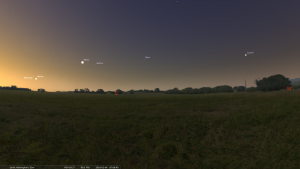
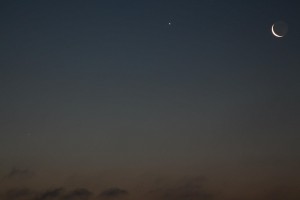
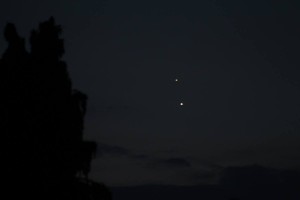
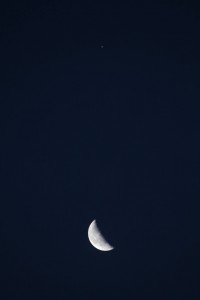
Leave a Reply